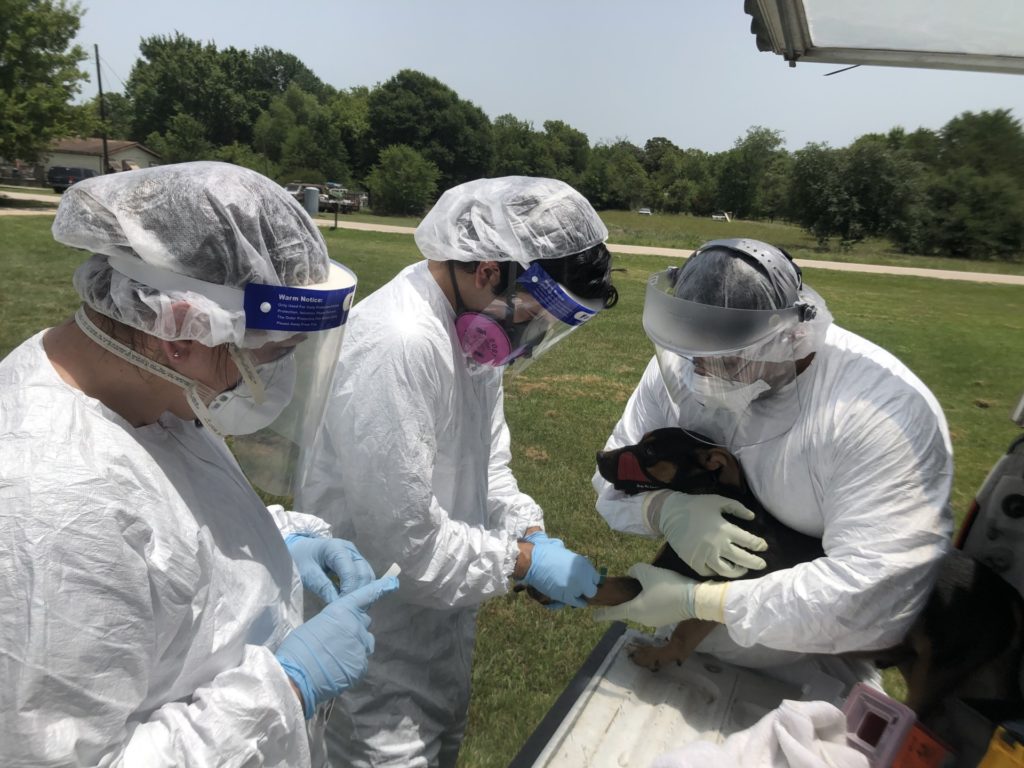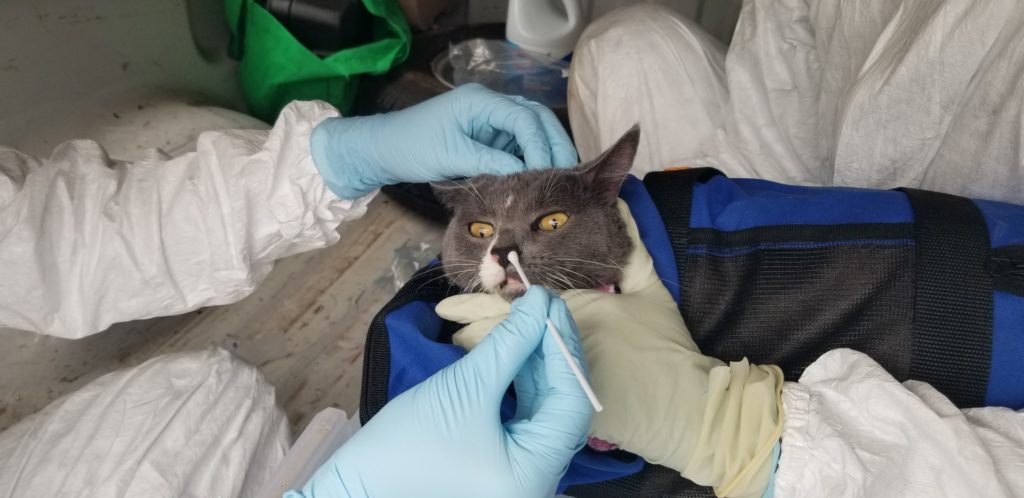Texas A&M research project identifies COVID-19 positive pets in Brazos County
Sampling dogs, cats whose owners tested positive aims to understand how pets may be impacted by SARS-CoV-2
The transmission of COVID-19 to pets has been the source of much discussion within the scientific community.
Reports have confirmed a small, but growing, list of positive cases among companion animals and exotic cats in the U.S. Now, new efforts within The Texas A&M University System are beginning to shed additional light on the topic.

A team led by Sarah Hamer, Ph.D., DVM, associate professor of epidemiology at the Texas A&M College of Veterinary Medicine and Biomedical Sciences, CVMBS, College Station, is further exploring the degree to which pets are infected with SARS-CoV-2, the virus that causes COVID-19.
In and around Brazos County, the team has found evidence that the pets of people who have COVID-19 may also become infected. Brazos County includes Bryan and College Station and is home to Texas A&M University.
“We’re one of a few veterinary schools across the country that are conducting similar investigations to provide an enhanced understanding about SARS-CoV-2 infections in pets—asking questions such as, are pets being exposed? Becoming infected? Can they spread the virus to humans or other animals? Do they get sick?” Hamer said. “It’s really exciting that research teams are beginning to respond to the crisis in this way.”
Collaborators in veterinary medicine, entomology and public health
In the ongoing project, Hamer has partnered with Gabriel Hamer, Ph.D., Texas A&M AgriLife Research entomologist in the Texas A&M College of Agriculture and Life Sciences, and Rebecca Fischer, Ph.D., Texas A&M School of Public Health. The team collaborates to recruit participants, sample pets at each household and test the samples in their laboratory facilities. Gabriel Hamer’s postdoctoral fellow Chris Roundy and research associate Wendy Tang, both in the College of Agriculture and Life Sciences Department of Entomology, are performing the initial swab testing.
“By actively surveilling pets that may not necessarily be symptomatic but are living with humans who have tested positive for COVID-19, Dr. Hamer’s project is significantly contributing to our understanding of the virus’s transmission pathways,” said John August, veterinarian and interim dean of CVMBS. “As such, this project reflects the dedication and leadership Texas A&M University has taken during this time, with three colleges collaborating, utilizing a One Health approach, to selflessly serve the global community and work toward answering questions that will help move us all—humans and pets alike—beyond the pandemic.”
So far, the team has identified two asymptomatic cats that tested positive for SARS-CoV-2. The cats, from different households, were both living with a person who was diagnosed with COVID-19.
“At the time we collected samples from these cats at their houses, the owners did not report any signs of disease in the animals coinciding with the human diagnosis, but one of the cats had several days of sneezing after we sampled it,” Hamer said.
Role of pets should be considered
“Our study was not designed to test the directionality of transmission of the virus (whether pets become infected from owners, or vice versa). But what this does tell us is that pets can become infected in high-risk households and pets should, therefore, be considered in the way we manage these households as part of the public health response,” Hamer said.
“The American Veterinary Medical Association and Centers for Disease Control and Prevention COVID-19 One Health Working Group emphasize that people who test positive should isolate from their pets or wear a face mask around their pets, just as they should do with other people,” she said. “We know that is probably really hard if you are quarantined at home and just want to snuggle with your pet, but it is important to do during a person’s illness to protect both human and animal health.”
Hamer reiterated that the veterinary and scientific consensus still maintains people shouldn’t be afraid if their animals test positive, and there is no indication that infected pets should be surrendered.
Testing protocols
The team is testing the samples in the researchers’ own Biosafety Level 2 and Level 3 research labs on campus. Samples that are initially positive on the two tests the Texas A&M labs perform are considered “presumptive positive.” Team members then send the initial positives to USDA’s National Veterinary Services Laboratories, NVSL, for confirmation. The team is also working with the Texas Department of State Health Services, DSHS, and the Texas Animal Health Commission, TAHC, in data reporting.
“We have a pretty rigorous testing approach here at A&M. After RNA extraction, the samples have to test positive in two different assays with our lab team before being sent to NVSL,” Hamer said. “All of our field and lab work has been through multiple approval processes with appropriate organizations in looking out for the animal’s and also humans’ best interest.”
The team plans to repeat the sampling of any pet with positive test results and to continue to communicate with pet owners. In addition, the team will attempt to isolate infectious virus from the swab samples and conduct antibody testing for all pets in the study to learn about animal infection and exposure.
Dozens of households sampled
Currently, animals can only be tested with approval from the DSHS state public health veterinarian and the TAHC state veterinarian. The Texas A&M Veterinary Medical Diagnostic Laboratory, TVMDL, works with DSHS and TAHC, and began performing tests for SARS-CoV-2 in April. At this time, the CDC and the U.S. Department of Agriculture do not recommend routine testing of animals for SARS-CoV-2.
Hamer’s team has been sampling pets living with a person who has been diagnosed with COVID-19 since mid-June. Owners can opt in for the project after being diagnosed with the disease.
“Our goal is to learn more about the different roles that pets may play in the transmission cycle of SARS-CoV-2 and to understand the timing of animal infections in relation to human infections,” Hamer said. “We hope the information will be used to enhance surveillance programs and, ultimately, help protect both human and animal health.”
Hamer is working closely with the Brazos County Health Department, which is helping share information about the project to those who test positive for pet-enrollment purposes. So far, the team has sampled several dozen households across the county. The collected data are contributing to a national database and will contribute to a scientific paper.
Looking to expand the study
Hamer’s team will be seeking funding to continue the work and to expand the geographic region of their sampling.
“We hope to continue to be right there to sample pets in these settings so we can contribute more to the emerging science on this topic,” Hamer said.
“Our field and lab teams—which include doctoral and postdoctoral researchers, research associates and scientists, and professors from the CVMBS and the College of Agriculture and Life Sciences—have been working really hard, and I appreciate that they’re willing to work long days, especially braving the heat with many layers of personal protective equipment, because it’s one small way we can learn more to help combat the pandemic.”
To learn more about the project, visit tx.ag/BCSCovidResearch.
Read the original story at the Texas A&M College of Veterinary Medicine and Biomedical Sciences.



